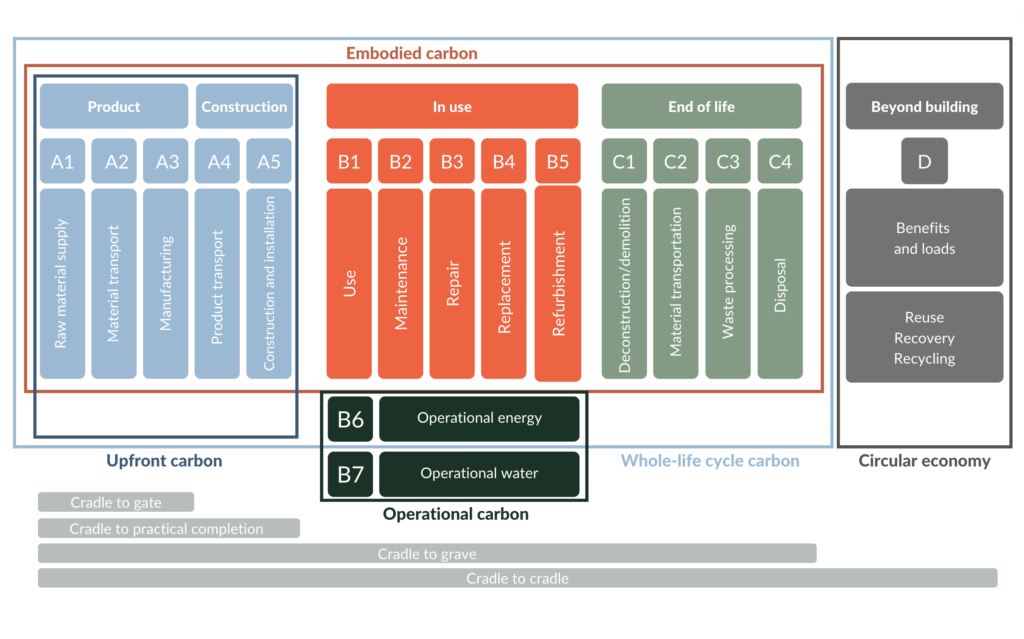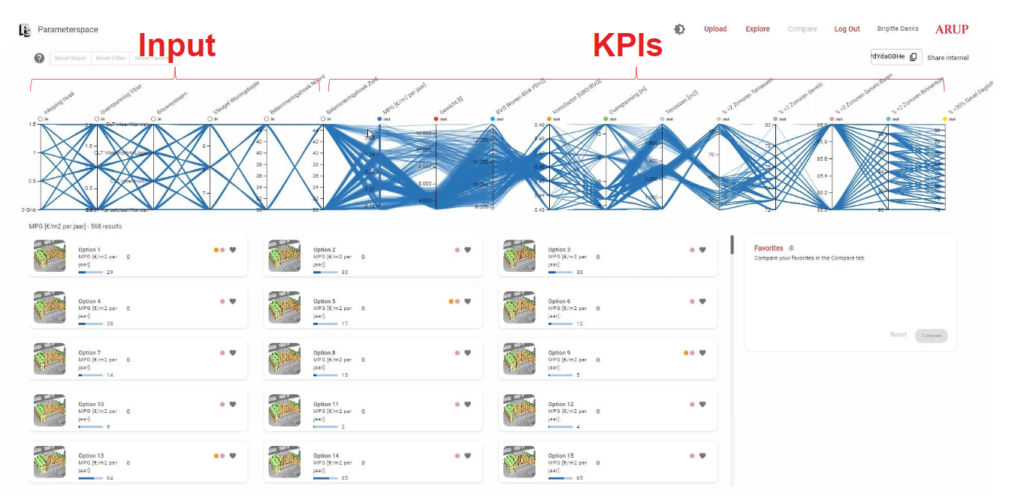On 1 September 2022, MECLA held a Spotlight on Pre-Design and Design Strategies for Lowering Embodied Carbon. Representatives from various organisations across the supply chain discussed the importance of the pre-design and design phases, exploring how embodied carbon is thought about in design, what design tools consider embodied carbon and whole of life carbon, how design interacts with other drivers of embodied carbon such as procurement, materials selections and decarbonisation, and how to scale these practices across industry.
Speakers:
- Lucy Marsland, Life-Cycle Assessment Practitioner at Atelier Ten
- Darryl Stuckey, Head of Sustainability Transformation at Lendlease
- Brigitte Danks, Structural Engineer at Arup
- Christopher Royal, Director Sustainability at Transport for NSW
- Will Arnold, Head of Climate Action at The Institution of Structural Engineers
- Ross Donaldson, Founder at EPM Experimental
Key Takeaways:
- Embodied carbon is measured in kg CO2 ~e / functional unit – amount of kilograms of carbon emissions per unit on a given project
- There is a lot of work that can be done before undertaking an Life-Cycle Assessment (LCA) to get good outcomes in reduction. These approaches include building less things, more cleverly, more efficiency, and building out waste.
- In Australia we take a perentage reduction approach to benchmarking LCAs. We need a rigorous and accessible approach to early design guidance and a detailed LCA that is tool-agnostic but shared across industry.
- Barangaroo precinct had a 20% embodied carbon reduction target across all projects. This was achieved through extensive supply chain engagement, asking suppliers about dematerialisation, low carbon substitutions & recycled content, manufacturing & sourcing, logistics & packaging, and finally carbon offsetting for unavoidable emissions.
- Substructures and superstructures account for 60% of a building’s embodied carbon, the rest comes from other components such as internal finishes and facades.
- At the brief stage of the project there are a number of questions we can ask to have a big impact on carbon emissions: do we need to demolish/build this or can we use the existing building? Can we optimise structural efficiency by reducing grid dimensions or having smaller floor loads? Can we use less carbon intensive materials like timber, supplementary cementitious materials, or greener steel if possible?
- Brigitte outlined the Arup inForm Tool. It compares design options at the project brief, runs thousands of design options and quantifies the results.
- Transport for NSW (TfNSW) is the largest consumer of materials in NSW and has a $77 Bn forward pipeline for projects. TfNSW recognising their procurement power and intends to drive demand for low carbon materials in infrastructure projects. They have recently begun their Sustainable Infrastructure for Industry Engagement initiative, the largest industry event for TfNSW.
If you missed the session, read a summary of what was discussed below:
Ross Donaldson, Founder at EPM Experimental, facilitated the event. He welcomed Wiill Arnold, Head of Climate Action at The Institution of Structural Engineers in England, who provided commentary throughout the various presentations. Lucy Marsland, Life-Cycle Assessment Practitioner at Atelier Ten, was the first speaker.
Lucy discussed measuring embodied carbon. Embodied carbon is measured in kg CO2-e/functional unit; the kilograms of carbon emissions per unit on a given project. Optimising design options and engaging the supply chain to uphold an embodied carbon budget is crucial on the pathway to Net Zero.

Lucy explained that building LCA is a simple AxB equation, multiplying the material quantity by the product’s environmental profile. But there is a lot of work that can occur before undertaking an LCA, working with design teams to get a good outcome before the LCA occurs. There is a hierarchy of design practices to reduce carbon. First, use less stuff; build nothing, less, more cleverly, more efficiently, or build out waste. The less we use, the less carbon emitted. Second, specify low carbon products. And third, offset.
In Australia we take a percentage reduction approach to benchmarking LCAs. Design approval documentation provides a preliminary reference and gives a 100% benchmark environmental impact. Then a proposed approach using an LCA demonstrates a percentage reduction in the construction documentation. Lucy called for a firming up of benchmarking, a rigorous and accessible approach to early design guidance and detailed LCA that is tool-agnostic but shared across industry, and collaboration to share and develop the practice through pre-competitive industry engagement across disciplines.
Darryl Stuckey, Head of Sustainability Transformation at Lendlease, presented on the Barangaroo case study. The focus here was on supply chain management. The Barangaroo project set several ambitious sustainability goals, one was to reduce embodied carbon for each building by 20% compared to standard construction practices. As Darryl said, in 2009 when the project started, they didn’t even have a clear idea of what embodied carbon was. There were few EPDs, and little standards for benchmarking. Embodied carbon road maps were developed for each project within the precinct. These were guided by LCA to establish baselines and targets. There were three focus areas for reduction: Design Optimisation, Products & Materials, and Onsite Construction.
Supply chain engagement activities focused on key materials that represented the most significant embodied carbon impact. They focused primarily on concrete, steel and façade. A key trade package priority list was developed for each project. This guided supply engagement discussions, specification developments, returnable schedules and embodied carbon roadmaps and assessments. They followed a similar hierarchy discussed by Lucy, asking suppliers about dematerialisation, low carbon substitution & recycled content, manufacturing & sourcing, logistics & packaging, and finally carbon offsetting for unavoidable emissions.
Lendlease learned four crucial practices for success.
- Timing: get in early and pick your moment, and have early engagement with suppliers.
- Education: educating oneself on your own supply chain and how the materials are used will help achieve better decarbonisation outcomes.
- Keep it simple: don’t overwhelm suppliers. Tailor the specification, and use clear and tailored returnable schedules based on product/material type.
- Data driven focus: focus on the big hitting items and use LCA to guide you. Set clear targets for design teams, suppliers and delivery teams.
Brigitte Danks, Structural Engineer at Arup, spoke next on the importance of the brief and the impact of structures on carbon reduction. Typically, substructures (foundations) and superstructures (above ground structure) account for 60% of a building’s embodied carbon. The rest comes from things like internal finishes and façade. Bridgitte stresses that the highest impact opportunity is from day 1, at the conception of the project.
At the brief stage of the project, you can have a big impact on the carbon emissions associated by making pre-emptive decisions. Bridgitte outlined how considering floor loading, grid spacing and materials can help reduce carbon significantly. It is important that these questions are asked at the project brief stage.
- Do we need to demolish/build this or can we use the existing building?
- Can we optimise structural efficiency by reducing grid dimensions or having smaller floor loads?
- Can we use less carbon intensive materials like timber, supplementary cementitious materials, or greener steel if possible?
Brigitte then turned to focus on the Arup inForm Tool. It compares design options at phase 1 of the project brief. Arup’s inForm Tool is fed the KPIs of the project (metreage, sunlight, energy, wind, CO2, transport, and sound), and the parameters it is allowed to vary. The tool then runs through thousands of design options and quantifies results.

Christopher Royal, Director Sustainability at Transport for NSW (TfNSW), spoke about building the business case for infrastructure. There are four pillars of decarbonisation for TfNSW decarbonisation:
- Operational Emissions: electrify and use renewable electricity and demand reduction and energy efficiency
- Enabled Emissions: accelerate uptake of EVs and low carbon technologies for freight
- Construction Emissions: Net Zero procurement and low carbon materials
- Investment Decisions: prioritise investments that support low carbon outcomes and ensure veracity of carbon offsetting
TfNSW is the largest consumer of materials in NSW and has a $77 Bn forward pipeline for projects. They have recently begun their Sustainable Infrastructure for Industry Engagement Initiative, the largest industry event for TfNSW. This initiative recognises procurement as one of the biggest levers TfNSW can pull to accelerate decarbonisation on the thousands of projects they are running at any given time, and looks to move from a linear consumption model to a circular development model to ensure long-term development.
They are also developing a Net Zero pathway and roadmap aligned to international standards that exist.
Chris stressed the important power of the asset investment lever, and how it can drive decarbonisation. Embedding appropriate externality values in projects helps inform the procurement process to achieve optimum outcomes.
Enabled emissions makes up the vast majority of the emissions in the sector. Emission reductions will be achieved through administering stamp duty exemptions and rebates to achieve the EV target, a Net Zero Freight strategy, and a hydrogen strategy.